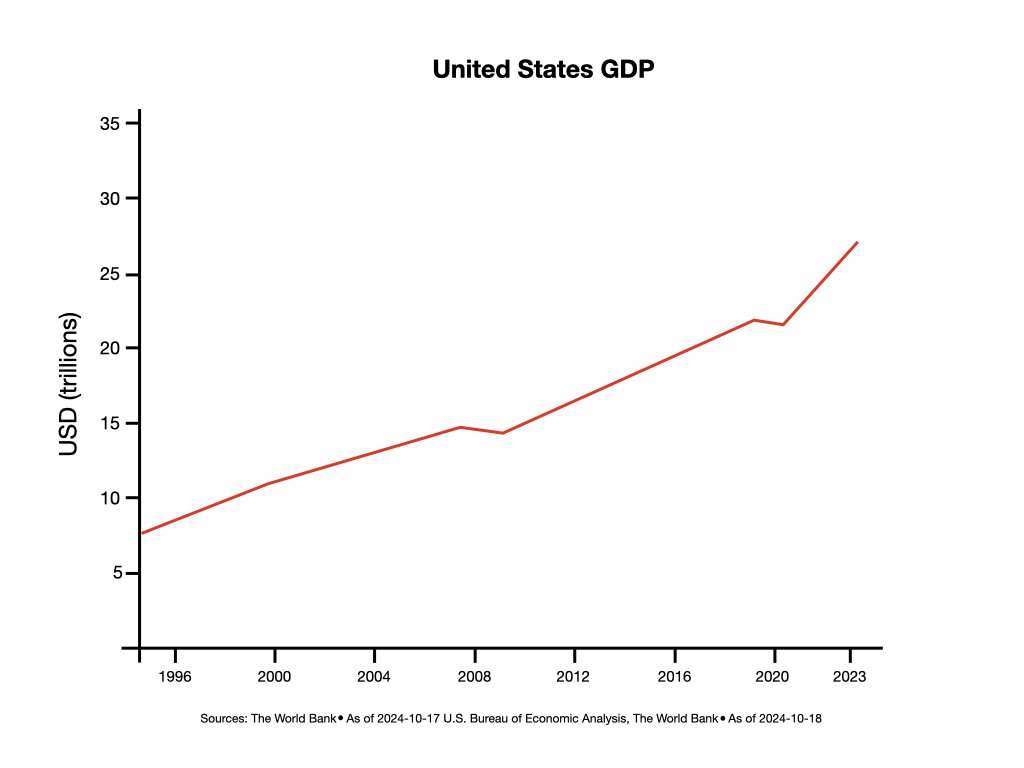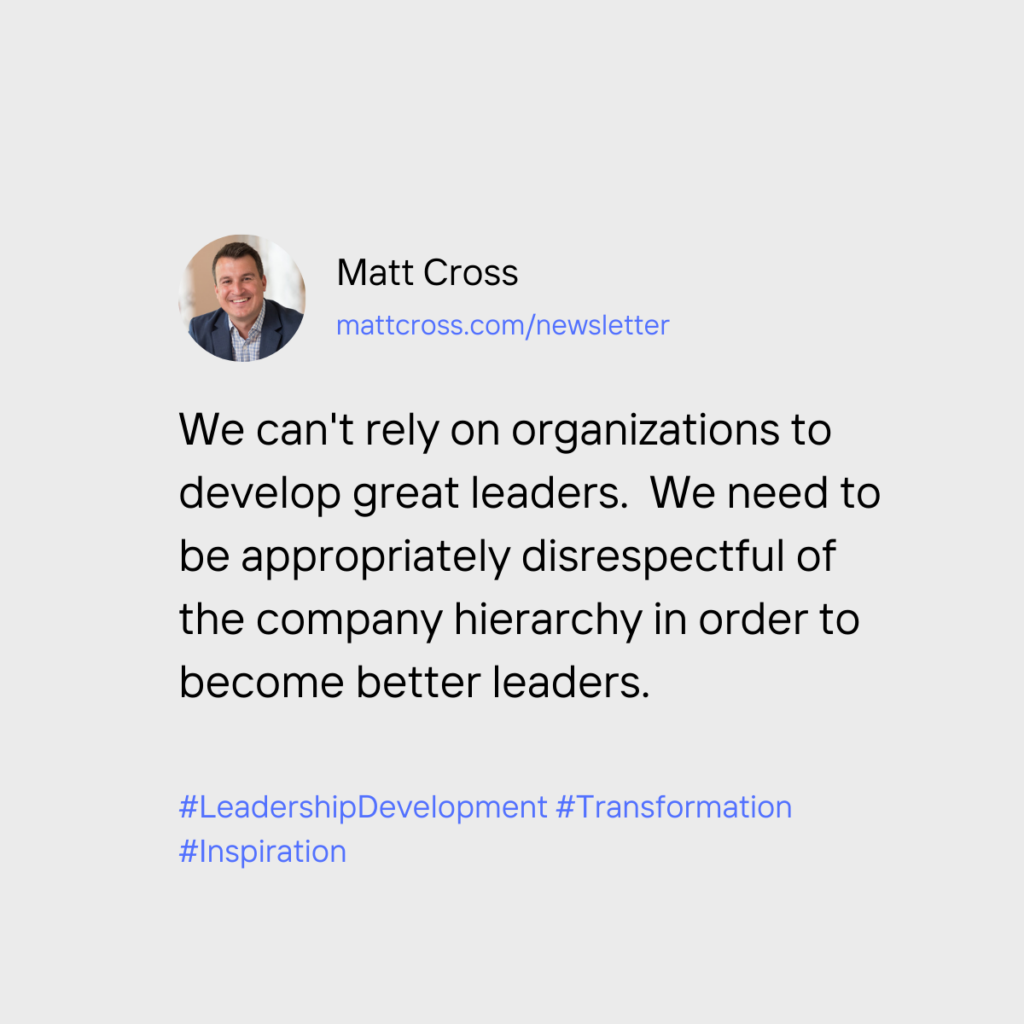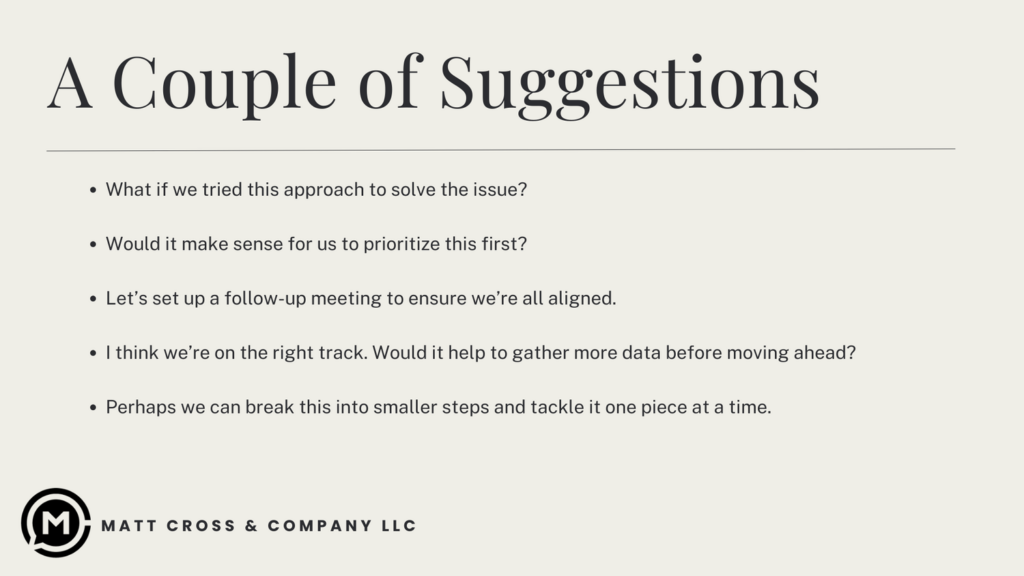Great leaders understand that leadership is a decision, not a position. They know that they can lead effectively in the real world without having an official leadership role. If you are wondering how to assume leadership without overstepping, this article will show you how.
Key Takeaways
- Reports suggest that companies are lacking confidence in the strength of their leadership bench and it is likely that your company seeks out individuals who are willing to lead without formal authority.
- You don’t have to be in an official leadership role or seek permission to act like a leader. Leadership is all about assumed authority.
- Anyone can take full responsibility for developing the personal qualities and leadership talent required of a leader.
- 5 things anyone can do to become better leaders, when they aren’t getting formal support from their organization.
We Need More Great Leaders
In 2023, Development Dimensions International (DDI) released a report showing that people are losing trust in leadership. The study was one of the largest and longest-running global studies on leadership and represented a sample of 1800 HR professionals and 14,000 leaders from 50 countries and 24 industries. What did they find?
- Only 40% of leaders believe that their organization has high quality leaders.
- Only 12% of companies report confidence in the strength of their leadership bench.
- 50% of CEOs say developing the next generation of leaders is a top challenge for their organization.
It is crucial to recognize that gifted candidates exist within organizations, and their potential must be identified and developed to prevent them from seeking opportunities elsewhere.
It is clear that we are facing a leadership talent shortage and there is no clear solution. Typical strategies and leadership development programs aren’t working and we need to find other ways to develop our people. Development training packages, like those offered by Common Purpose, can be essential tools for empowering leaders to operate effectively beyond traditional authority structures. In a demanding business environment we should think about liberating leadership talent instead of controlling it.
You Can Assume Leadership Without Being in a Formal Leadership Role
I am constantly amazed at how many people feel that they must seek permission before they step up and lead. They believe that organizations should equip individuals with leadership experiences or formal titles before they can lead and they fail to realize that they don’t need to be in an inner circle to exercise leadership.
Leadership is about influence, not titles. It’s the ability to step up, take responsibility, and guide others toward a common goal regardless of your position. You don’t need a formal role or special permission to lead. What truly defines leadership is your willingness to step into the gap, offer solutions, and support others. One real-world example is how employees at Coca-Cola’s brand ambassador program empower themselves to dissolve boundaries between their roles and broader community engagement.
In fact, some of the most impactful leaders operate from the sidelines. They’re the ones who drive change through action, collaboration, and example. They see what needs to be done and take the initiative, inspiring those around them to follow. Leadership is about owning your strengths, taking accountability, and making a positive difference wherever you are.
Instead of waiting to be anointed or brought into the inner circle, start leading by doing. Speak up in meetings, mentor others, tackle challenges head-on, and most importantly, bring people along with you. Leadership, at its core, is about creating impact and guiding others, no matter your title or place in the organizational chart.
Here are five ways you can assume leadership without stepping on anyone’s toes.
1. Recognize The Challenge Your Organization is Facing
Take a long hard look at your own business operation. Look at your organization as an owner would and realize that your organization or business may be a bit bloated. The U.S. economy has grown significantly over the last 30 years. In 1995, when I was still listening to grunge music, the U.S. GDP was approximately $7.64 trillion. At the end of 2023 it was $27.72 trillion.

What this means is that many of our organizations have been living high on the hog. Sure we’ve had a few ups and downs and not all businesses did well during this timeline, but we haven’t had a downturn so significant and long-term to really create a hard reset in how we operate across the board. The Covid pandemic was close but it was only a blip in the radar.
What do you think happens after all of this significant and steady growth, coupled with a scare like the Covid pandemic?
- We get comfortable
- We get complacent
- We get cautious
Actually, that last bullet should tell it like it is. We get AFRAID. VERY VERY AFRAID.
Business owners and C-Level Executives won’t tell you this but many of them are operating in a state of fear. Many are so fearful they don’t even realize it. They are worried that it is all going to fall apart and they are playing more defense than offense. This doesn’t apply to all business leaders but I can assure you it applies to many.
Even if it doesn’t apply to your leadership the pressure of continuing to perform and grow year after year is exhausting.
Why does this matter to you, the person who assumed authority and took on an informal, unendorsed leadership role? Here’s something I’ve only shared with my own inner circle but I’m sharing it now to empower prospective leadership candidates:
We can’t rely on organizations to develop great leaders. We need to be appropriately disrespectful of the company hierarchy in order to become better leaders.

2. Tune Into Civil and Cultural Norms
In Steven Covey’s book The Seven Habits of Highly Effective People he tells us to “Seek First to Understand, Then to be Understood.”
This is wisdom at its finest and exactly what I am talking about when I suggest that we need to tune into civil and cultural norms. If you aren’t in a leadership position but you feel compelled to step up and lead you need to understand the culture and the climate. If you don’t you’ll show up like a bull in a china shop and do a lot of damage.
Several years ago I worked with a collegue who desperately wanted to make a name for himself. He was incredibly ambitious and thought everyone around him was lazy and ill equipped to contribute to, let alone lead the organization. He was super smart but super critical and one day he tried to take the lead on something without having the authority present. It backfired on him in ways he didn’t anticipate and within 6 months the business let him go.
He wasn’t let go because he tried to take the lead. He was let go because he never took the time to understand the norms of the organization. He failed to read the tea leaves and fit into the culture. He ignored the cultural signals that were loud and clear and pushed back against them like a stubborn child.
3. Develop Your Personal Authority
Personal authority is the influence one earns through trust and relationships with others. It is an intangible asset that is subtle but incredibly powerful. Whenever I think about authority I think about my friend Jim. Jim is one of those guys that people respect dearly. They respect him, trust him, look up to him and want to please him because he has that gravitas that others look for in a leader.
How did he get that Gravitas? Most would think it comes from the fact that he was the CEO of a pretty amazing business that he built from the ground up and recently sold for a good chunk of change. Others would think it comes from his wallet – he has a lot of money and can throw that money around to get others to do what he wants. But anyone who thinks these things would be gravely mistaken.
Jim’s gravitas comes from the relationships and the trust he has built with so many people. He is the consumate brand ambassador for his business, community and personal brand. He is self-less and supportive and committed to trust and integrity. His employees talk fondly about his commitment to empowering workers. When you sit down with him on a one to one basis you realize that he is interested in you and fully present. When you talk to him you quickly realize that he cares about you and your well being. He makes things simple when others would swear that things are increasingly complex.
Even though Jim is incredibly busy, he always finds time to be a steward of his community. He is one of those guys that is so grounded and quietly confident, you just can’t help but look up to him. He embodies a clear set of values and lives by a few core principles. He makes clear commitments and follows through on those commitments. He isn’t perfect, but he is who he is and when you deal with him you know what you’ll get. Jim is the essence of authority and a role model for anyone who wants to step up and lead.
4. Listen Before You Act
One of the quickest ways to undermine your leadership, is to jump into action without fully understanding the landscape. It’s tempting to want to prove yourself by being the first to offer solutions, but wise leaders know that listening is the foundation of real influence. Before you act, take the time to observe, ask questions, and listen – really listen.
In addition to listening, engaging in outreach and educational endeavors is crucial for building trust and influence. Empowering employees to act as brand ambassadors can extend your message beyond internal boundaries, fostering community engagement and enhancing your organization’s credibility.
Listening doesn’t just mean hearing what’s said; it means reading between the lines. People’s words, tone, body language – there’s a lot more going on than the surface conversation. The best leaders pick up on these subtle cues in communication. They understand the power dynamics, the unspoken concerns, and the underlying tensions that others might miss.
Early in my career, I worked with a leader who did this brilliantly. Whenever a big challenge came up, while others were quick to throw out ideas, she would sit back and listen to every voice in the room. She wasn’t in a rush to speak or act. She asked thoughtful questions and listened closely to every response. After the noise died down, she’d calmly offer her perspective, which always hit the mark. Why? Because she took the time to understand not just the problem, but the people involved.
This level of attentiveness does more than equip you with the right information; it builds trust. When people feel heard, they’re far more likely to follow your lead. And when you understand their perspectives, your actions are more likely to hit the target. Leadership isn’t about being the loudest voice in the room; it’s about being the most attuned.
So, before you act, pause and listen. You’ll be amazed at how much you can accomplish when you start with understanding rather than action.
5. Offer Suggestions Not Orders or Ultimatums
Nothing stifles collaboration faster than coming off as a dictator. Even if you’re absolutely sure you’ve got the right answer, offering it as a command – or worse, an ultimatum – will only create resistance. People don’t want to feel forced into action; they want to feel like they’re part of the solution. That’s why assumed leadership requires suggestions, not mandates.
When you step into an informal leadership role, your authority isn’t formalized, and that’s actually a good thing. Without the weight of a title, you have the freedom to influence through ideas, not directives. People will be far more receptive if you frame your contributions as suggestions. Think of yourself as a collaborator, not a commander.
Here’s how it works: Instead of saying, “We need to do this” try, “What if we approached it this way”. A small shift in language can make a world of difference. You’re not telling people what to do; you’re inviting them to consider a solution. You’re giving them space to weigh in, which not only empowers them but makes it more likely they’ll buy into your vision.

I once worked with someone who learned this the hard way. He was brilliant – always the smartest guy in the room – but he had a habit of presenting his ideas as the only possible solution. When things didn’t go his way, he’d issue ultimatums, as if there were no other options. It alienated people. Eventually, his ideas were shut down before they even had a chance to take off, simply because no one wanted to feel dictated to. His inability to suggest, rather than command, cost him influence.
On the other hand, I’ve seen leaders who know how to guide a team without strong-arming them. They offer ideas with humility and curiosity, encouraging feedback and adjustments along the way. They understand that leadership isn’t about always being right; it’s about moving the conversation forward. When you do this, people naturally rally around you – not because they’re told to, but because they choose to.
So, if you’re stepping up to lead without formal authority, remember: influence is more powerful than control and subtle shifts make all the difference in the world. Offer suggestions, not orders, and let others come to their own conclusions. You’ll be surprised how often they land exactly where you hoped they would.
Summary
Leadership isn’t about titles – it’s about taking responsibility and guiding others, regardless of your formal position. To lead without overstepping, it’s crucial to understand your organization’s culture. Failing to tune into civil and cultural norms and failing to break through traditional hierarchies in your own organization can stifle your growth and keep you from developing your personal authority.
Frequently Asked Questions
What is assumed leadership?
Assumed leadership involves individuals proactively taking on leadership roles without awaiting official recognition or titles. This approach can be crucial for driving change and fostering collaboration within a team.
How can I show up with more authority?
To recognize and embrace your authority, identify your position within the Inner and Outer Circles of authority, take ownership of your role, and lead with clarity. This approach will empower you and enhance your impact.
What barriers might I face?
Prospective leadership candidates often face barriers such as lengthy and bureaucratic HR filters that hinder capable employees from advancing into leadership. This can stifle talent and limit opportunities for qualified individuals.
How do I help others see my management potential?
If you are a good manager who is highly organized, recognize that this doesn’t necessarily translate in the minds of those who are looking for a leader. Leadership is more about navigating relationships and team dynamics. Its about working with and through others to produce outcomes for the outside world. If you are too focused on your inner circle and ignore team dynamics you may struggle to show you are a leader.
How can I break through traditional hierarchies?
You can break through traditional hierarchies by embracing different leadership roles when others won’t step up to lead. Assumed leadership is all about taking the lead when others won’t and taking the lead is often subtle. When someone struggles to make a decision, offer a suggestion. When someone struggles to clearly assign a task ask a follow up question to seek further clarity. By acting with courage you can demonstrate your leadership talent and work around the hierarchy.

